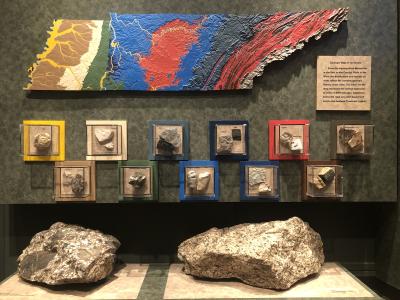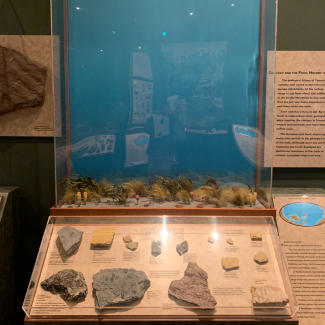For kids and kids at heart, there’s nothing like the wonder of dinosaur bones and fossils. October 13 happens to be National Fossil Day, and we’d like to share the hidden gem that is McClung Museum of Natural History & Culture. This facility is a Smithsonian Affiliate and located on the campus of the University of Tennessee (get to know UT and surrounding area here), and there is free parking in Circle Park (stop at the kiosk for a pass) and the museum itself is free.
The McClung Museum offers several permanent exhibits, including:
• Ancient Egypt: The Eternal Voice
• Archaeology & the Native Peoples of Tennessee
• The Decorative Experience (artistic artifacts from around the world)
• Tennessee Freshwater Mussels
• Human Origins: Searching for our Fossil Ancestors
• Geology & Fossil History of Tennessee

Geology & Fossil History of Tennessee
You’ve no doubt been to natural history museums before, why should you visit McClung Museum? The Geology & Fossil History Exhibit explains the fossil record for East Tennessee and the surrounding region specifically, meaning it is a unique experience from any other collection. Upon entering this exhibit, a panel demonstrates the geology of Tennessee with various types of rocks found here. You’ll also see a cast of a Mosasaur above. Giant reptiles of the sea, mosasaurs are not dinosaurs. They belong to the Order Squamata, which includes lizards. These fossils occur in Cretaceous Period deposits of West Tennessee.

Geology & Fossil History of Tennessee with Mosasaur Cast
Go counterclockwise to see the dioramas and fossils that depict eight major time periods in the geologic history of the state. Starting with the Cambrian time period – the earliest – you’ll see fossils and matching panels from the Ordovician, Silurian, Devonian, Mississippian, Cretaceous, Paleogene, and Neogene Periods.

Cambrian Period

Silurian & Devonian Period

Cretaceous Period
The changing landscape over time results in a variety of prehistoric creatures found in this area. They have an extensive collection of trilobites, and you can ask for a trilobite scavenger hunt print-out to make the most of your visit.

“Monty” the Edmontosaurus
 Closeup of teeth battery of Edmontosaurus
Closeup of teeth battery of Edmontosaurus
 Theropod footprint cast
Theropod footprint cast
The center of the gallery includes many fossils and casts of dinosaur remains, including the only dinosaur bones found in Tennessee and a collection of authentic dinosaur eggs from China. And of course, we can’t forget the University of Tennessee’s “Oldest Vol” – Monty, an Edmontosaurus annectens! The 2,400-pound, 24-foot-long bronze skeleton of the Edmontosaurus was installed in front of the museum in 2013 in honor of museum’s fiftieth anniversary celebration.
The Edmontosaurus is a hadrosaur, or duck-billed dinosaur, and these types of dinosaurs once roamed the coastal plains of Tennessee. The McClung Museum also houses actual hadrosaur bones—the only non-avian dinosaur bones ever found in the state.
Thriving in the late Cretaceous period about 66 to 65 million years ago, the Edmontosaurus was a large, plant-eating dinosaur with powerful legs, hoof-like nails, and a leathery hide with zebra-like patterning on the tail. It could run on two legs or walk on four legs, weighed approximately 7,000 to 8,000 pounds and reached up to 40 feet in length.

Human Origins: Searching for our Fossil Ancestors
Don’t forget to head to the lower level to see more fossils in the exhibit Human Origins: Searching for our Fossil Ancestors. Guiding the museum in the creation of this exhibition was Andrew Kramer, head of UT’s Department of Anthropology. Kramer is a physical anthropologist specializing in paleoanthropology, the study of human evolution. The exhibition employs numerous casts of fossil hominids, artists’ reconstructions of life scenes, maps, diagrams, videos, and artifacts.

If you didn’t catch this on your way in, you’ll notice fossilized wood leading up to the entrance of the museum. There are fossils to be found everywhere, so come for a visit and celebrate National Fossil Day!


